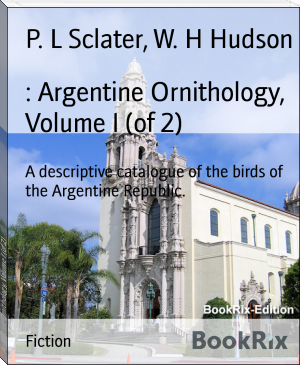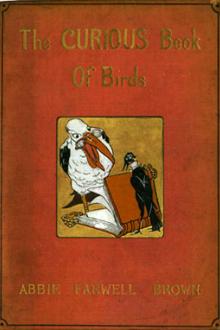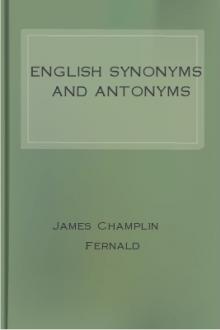: Argentine Ornithology, Volume I (of 2), P. L Sclater, W. H Hudson [best authors to read txt] 📗

- Author: P. L Sclater, W. H Hudson
Book online «: Argentine Ornithology, Volume I (of 2), P. L Sclater, W. H Hudson [best authors to read txt] 📗». Author P. L Sclater, W. H Hudson
nearly finished. I am sure that this nest will be attacked before long,
and I have resolved to watch it closely.
September 28.--To-day I saw a Bay-wing (_M. badius_) on the nest; it
climbed over it, deliberately inspecting every part with the critical
air of a proprietor who had ordered its construction, taking up and
rearranging some sticks and throwing others away from the nest. While
thus engaged, two common Cow-birds (_M. bonariensis_), male and female,
came to the tree; the female dropped on to the nest, and began also to
examine it, peering curiously into the entrance and quarrelling with the
first bird. After a few minutes she flew away, followed by her glossy
consort. The Bay-wing continued its strange futile work until the owners
of the nest appeared, whereupon it hopped aside in its usual slow
leisurely manner, sang for a few moments, then flew away. The similarity
in the behaviour of the two birds struck me very forcibly; in the great
interest they take in the nests of other birds, especially in
large covered nests, the two species are identical. But when the
breeding-season comes their habits begin to diverge: then the Common
Cow-bird lays in nests of other species, abandoning its eggs to their
care; while the Bay-wings usually seize on the nests of other birds
and rear their own young. Yet, as they do occasionally build a neat
elaborate nest for themselves, the habit of taking possession of the
nests of other birds is, most likely, a recently acquired one, and
probably its tendency is to eradicate the original building instinct.
October 8.--This morning, while reading under a tree, my attention was
aroused by a shrill note, as of a bird in distress, issuing from the
neighbourhood of the Leñatero's nest; after hearing it repeated at
intervals for over twenty minutes, I went to ascertain the cause. Two
Bay-wings flew up from the ground under the nest, and on searching
in the rank clover growing under the tree, I discovered the female
Leñatero, with plumage wet and draggled, trembling and appearing half
dead with the rough treatment she had experienced. I put her in the
sun, and after half an hour, hearing her mate calling, she managed to
flutter feebly away to join him. The persecutors had dragged her out
of the nest, and would, no doubt, have killed her, had I not come so
opportunely to the rescue.
Since writing the above, I have continued to watch the nest. Both the
Bay-wings and Leñateros left it for some days. Six days after picking up
the ill-treated female, the Leñateros came back and resumed possession.
Four days later the Bay-wings also came back; but on finding the
nest still occupied, they took possession of an unfinished oven of
an Oven-bird on another tree within twenty yards of the first, and
immediately began carrying in materials with which to line it. When they
had finished laying I took their five eggs, at the same time throwing
down the oven, and waited to see what their next move would be. They
remained on the spot singing incessantly, and still manifesting anxiety
when approached. I observed them four days, and then was absent from
home as many more; on returning, I found that the Leñateros had once
more disappeared, and that the nest was now held by the Bay-wings. I
also noticed that they had opened an entrance very low down at the side
of the nest which they were using; no doubt they had killed and thrown
out the young Leñateros.
It was now early in November, the height of the breeding-season, and
numbers of Common Cow-birds constantly visited the nest; but I was
particularly interested in a pair of Screaming Cow-birds that had also
began to grow fond of it, and I resolved to watch them closely. As they
spent so much of their time near the nest, showing great solicitude
when I approached it, I strongly hoped to see them breed in it, if the
Bay-wings could only be got rid of. The Screaming Cow-birds would
not, or dared not, attack them; and, as I always think that the worst
possible use one can put a little bird to is to shoot it, I could not
help them by destroying the Bay-wings. I therefore resolved to take
their eggs, hoping that that would cause them to leave in disgust.
When I was satisfied from their movements that they had finished laying,
I got up to the nest, and was astonished to find _ten_ eggs instead of
five, as I had confidently expected; for, though the Common Cow-birds
had paid a great deal of attention to the nest, I knew the Bay-wings
would not allow _them_ to lay in it.
The ten eggs in the nest were all unmistakably Bay-wing's eggs; and
having observed before that several females do occasionally lay
together, I concluded that in this case two females had laid in the
nest, though I had only seen two birds--male and female. After taking
the ten eggs the Bay-wings still remained, and in a very short time they
appeared to be laying again. When I had reason to think that the full
complement was laid, I visited the nest and found five eggs in it; these
I also took, and concluded that the second female had probably gone
away, after having been deprived of her first clutch. During all
this time the Screaming Cow-birds remained in the neighbourhood and
occasionally visited the tree; but to my very great surprise the
Bay-wings still stubbornly remained, and by-and-by I found that they
were going to lay again--the fourth time! When I next visited the nest
there were two eggs in it; I left them and returned three days later,
expecting to find five eggs, but found seven! certainly more than one
female had laid in the nest on this occasion. After taking these last
seven eggs the Bay-wings left; and though the Screaming Cow-birds
continued to make occasional visits to the nest, to my great
disappointment they did not lay in it.
April 12.--To-day I have made a discovery, and am as pleased with it as
if I had found a new planet in the sky. The mystery of the Bay-wings'
nest twice found containing over the usual complement of eggs is cleared
up, and I have now suddenly become acquainted with the procreant
instinct of the Screaming Cow-bird. I look on this as a great piece of
good fortune; for I had thought that the season for making any such
discovery was already over, as we are so near to winter.
The Bay-wings are so social in their habits that they always appear
reluctant to break up their companies in the breeding-season; no sooner
is this over, and while the young birds are still fed by the parents,
all the families about a plantation unite into one flock. About a month
ago all the birds about my home had associated in this way together, and
went in a scattered flock, frequenting one favourite feeding-spot very
much, a meadow about fifteen minutes' walk from the house. The flock was
composed, I believe, of three families, sixteen or eighteen birds in
all: the young birds are indistinguishable from the adults; but I knew
that most of these birds were young hatched late in the season, from
their incessant strident hunger-notes. I first observed them about the
middle of March. A week ago, while riding past the meadow where they
were feeding, I noticed among them three individuals with purple spots
on their plumage. They were at a distance from me, and I naturally
concluded that they were young Common Cow-birds (_M. bonariensis_),
casually associating with the Bay-wings. I was surprised to see them,
for the young male _M. bonariensis_ always acquires the purple plumage
before March, so that these individuals were changing colour five weeks
after the usual time. To-day, while out with my gun, I came upon the
flock, and noticed four of the birds assuming the purple plumage, two
of them being almost entirely that colour; but I also noticed with
astonishment that they had bay- or chestnut-coloured wings, also that
those with least purple on them were marvellously like the Bay-wings in
the mouse-coloured plumage of the body and the dark tail. I had seen
these birds before the purple plumage was acquired, and there was then
not the slightest difference amongst them, the adults and their supposed
offspring being alike; now some of them appeared to be undergoing the
process of a transmutation into another species! I at once shot the four
spotted birds along with two genuine Bay-wings, and was delighted to
find that the first were young Screaming Cow-birds.
I must now believe that the extra eggs twice found in the nest of the
Bay-wings were those of the Screaming Cow-bird, that the latter species
lays chiefly in the nests of the former, that the eggs of the two
species are identical in form, size, and colour, each bird also laying
five, and that, stranger still, the similarity is as perfect in the
young birds as it is in the eggs.
April 15.--This morning I started in quest of the Bay-wings, and
observed one individual, that had somehow escaped detection the day
before, assuming the purple dress. This bird I shot; and after the flock
had resettled a short distance off, I crept close up to them, under the
shelter of a hedge, to observe them more narrowly. One of the adults was
closely attended by three young birds; and these all, while I watched
them, fluttered their wings and clamoured for food every time the old
bird stirred on its perch. The three young birds seemed precisely alike;
but presently I noticed that one of them had a few minute purple spots,
and on shooting this one I found it to be a young _M. rufoaxillaris_,
while the other two were true young Bay-wings.
The hunger-cry of the young _M. badius_ (Bay-wing) is quite different
from that of the young _M. bonariensis_: the cry of the latter is a
long, shrill, two-syllabled note, the last syllable being prolonged into
a continuous squeal when the foster-parent approaches with food; the cry
of the young _M. badius_ is short, reedy, tremulous, and uninflected.
The resemblance of the young _M. rufoaxillaris_ to its foster-brothers
in language and plumage is the more remarkable when we reflect that the
adult bird in its habits, gestures, guttural notes, also in its deep
purple plumage, comes much nearer to _M. bonariensis_ than to _M.
badius_. It seems impossible for mimicry to go further than this. A
slight difference in size is quite imperceptible when the birds are
flying about; while in language and plumage the keenest ornithologist
would not be able to detect a difference. But it may be questioned
whether this is really a case of an external resemblance of one species
to another acquired by natural selection for its better preservation.
Possibly the young _M. rufoaxillaris_, in the first stage of its
plumage, exhibits the ancestral type--that of the progenitor of both
species. If _M. badius_ belonged to some other group--_Sturnella_ or
_Pseudoleistes_, for instance--it would scarcely be possible to
doubt that the resemblance of the young _M. rufoaxillaris_ to its
foster-brothers resulted from mimicry; but as both species belong to
the limited, well-defined group _Molothrus_, the resemblance may be
ascribed to community of descent.
Formerly I believed that though _M. badius_ is constantly seen rearing
its own young, they also occasionally dropped their eggs in the nests
of other birds. I could not doubt that this was the case after having
witnessed a couple of their young following a Yellowbreast and being
fed by it. I must now alter my opinion, for what then appeared to be
proof positive is now no proof at all, for those two birds were probably
the young of _M. rufoaxillaris_. There are, however, good reasons for
believing that _M. rufoaxillaris_ is parasitical almost exclusively
on _M. badius_. I have spoken of the many varieties of eggs _M.
bonariensis_ lays. Those of _M. badius_ are a trifle less in size,
in form elliptical, densely and uniformly marked with small spots
and blotches of dark reddish colour, varying to dusky brown; the
ground-colour is white, but sometimes, though rarely, pale blue. It is
not possible to confound the eggs of the two species. Now, ever since
I saw, many years ago, the Yellowbreast feeding the supposed young
Bay-wings, I have looked out for the eggs of the latter in other
birds' nests. I have found hundreds of nests containing eggs of _M.
bonariensis_, but never one with an egg of _M. badius_, and, I may now
add, never one with an egg of _M. rufoaxillaris_. It is wonderful that
_M. rufoaxillaris_ should lay only in the nests of _M. badius_; but
the most mysterious thing is that _M. bonariensis_, indiscriminately
parasitical on a host of species, never, to my knowledge, drops an egg
in





Comments (0)